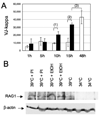Requirement for ubiquitin conjugation and 26S proteasome activity at an early stage in V(D)J recombination
- PMID: 20116856
- PMCID: PMC2830333
- DOI: 10.1016/j.molimm.2010.01.004
Requirement for ubiquitin conjugation and 26S proteasome activity at an early stage in V(D)J recombination
Abstract
V(D)J recombination, the process that rearranges gene segments to assemble mature antigen receptor genes, relies on a recombinase comprising the RAG1 and RAG2 proteins. RAG1 is a multi-functional enzyme including DNA binding and cleavage as well as ubiquitin ligase activities, all of which appear to contribute to its role in recombination. Here we demonstrate that components of the ubiquitin conjugation machinery and the 26S proteasome are required for an early step in V(D)J recombination. Inhibitors of the 26S proteasome and ubiquitin activating enzyme (E1) blocked both chromosomal and extra-chromosomal recombination when added 1h following transfection/induction, but they had no effect when added 16 h later. There was no effect on expression of RAG1, and recombination did not require transit through the cell cycle, confirming that inhibition was not due to an indirect effect on cell cycle arrest or protein expression. Experiments in which RAG1 translation was blocked with cyclohexamide after 16 h of expression indicated that many active recombination complexes were formed within this window, although recombination products continued to accumulate for 48 h. These data suggest that ubiquitin-dependent degradation is an early step in complex assembly or activation, and are consistent with our previous hypothesis that degradation of a negative regulator is required to trigger recombination.
Copyright 2010 Elsevier Ltd. All rights reserved.
Conflict of interest statement
The authors declare no financial conflicts of interest.
Figures





Similar articles
-
The roles of the RAG1 and RAG2 "non-core" regions in V(D)J recombination and lymphocyte development.Arch Immunol Ther Exp (Warsz). 2009 Mar-Apr;57(2):105-16. doi: 10.1007/s00005-009-0011-3. Epub 2009 Mar 31. Arch Immunol Ther Exp (Warsz). 2009. PMID: 19333736 Review.
-
Correlation between recombinase activating gene 1 ubiquitin ligase activity and V(D)J recombination.Immunology. 2009 Oct;128(2):206-17. doi: 10.1111/j.1365-2567.2009.03101.x. Immunology. 2009. PMID: 19740377 Free PMC article.
-
Mutational analysis of RAG1 and RAG2 identifies three catalytic amino acids in RAG1 critical for both cleavage steps of V(D)J recombination.Genes Dev. 1999 Dec 1;13(23):3059-69. doi: 10.1101/gad.13.23.3059. Genes Dev. 1999. PMID: 10601032 Free PMC article.
-
Recombination centres and the orchestration of V(D)J recombination.Nat Rev Immunol. 2011 Apr;11(4):251-63. doi: 10.1038/nri2941. Epub 2011 Mar 11. Nat Rev Immunol. 2011. PMID: 21394103 Review.
-
CTCF-binding elements mediate control of V(D)J recombination.Nature. 2011 Sep 11;477(7365):424-30. doi: 10.1038/nature10495. Nature. 2011. PMID: 21909113 Free PMC article.
References
-
- Chen YY, Wang LC, Huang MS, Rosenberg N. An active v-abl protein tyrosine kinase blocks immunoglobulin light-chain gene rearrangement. Genes Dev. 1994;8:688–697. - PubMed
-
- Desiderio S, Lin WC, Li Z. The cell cycle and V(D)J recombination. Curr. Top. Microbiol. Immunol. 1996;217:45–59. - PubMed
-
- Gellert M. V(D)J recombination: RAG proteins, repair factors, and regulation. Annu. Rev. Biochem. 2002;71:101–132. - PubMed
-
- Guloglu FB, Bajor E, Smith BP, Roman CA. The unique region of surrogate light chain component lambda5 is a heavy chain-specific regulator of precursor B cell receptor signaling. J Immunol. 2005;175:358–366. - PubMed
Publication types
MeSH terms
Substances
Grants and funding
LinkOut - more resources
Full Text Sources
Research Materials

